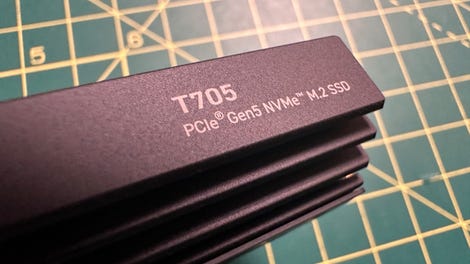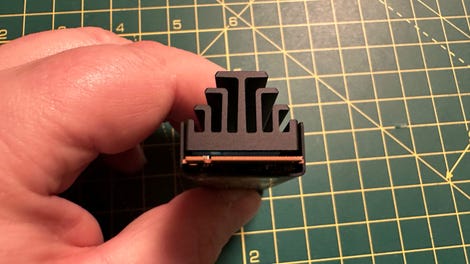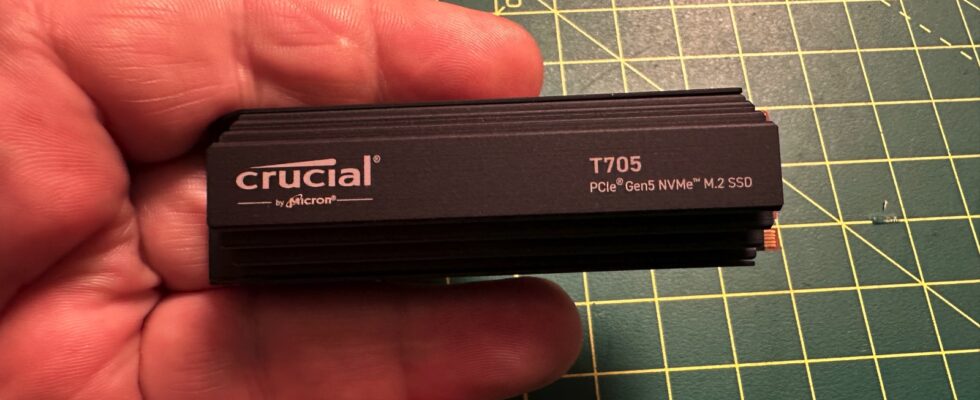The Crucial T705 PCIe Gen5 NVMe M.2 SSD features a monstrous heatsink. Adrian Kingsley-Hughes/ZDNET
Over the years, I’ve found that people tend to blame the processor or RAM for the slowness of their computer. However, more often than not, the real culprit is the storage instance.
Yes, many of you overlook the significant impact that storage can have on overall system speed.
ZDNET’s Key Findings for the Crucial T705 PCIe Gen5 NVMe M.2 SSD
- The new Crucial T705 PCIe Gen5 NVMe M.2 SSD goes on sale March 12, but it can be pre-ordered now.
- It offers ultra-fast performance, with the added option of a heatsink version
- It is expensive and not everyone can benefit from the performance it offers.
The good news is that the performance of modern storage solutions is extraordinary, with read and write speeds that just a few years ago would have been considered purely gimmicky.
Today’s storage systems are not only faster, but also more reliable and offer much larger capacities, transforming what we want from our devices and how we use them.
Yes he East incredibly fast
This means that storage is now a key consideration when considering upgrading an existing system.
Over the past two weeks, I’ve been testing Crucial’s new SSD, which the company touts as the world’s fastest. And yes, he East incredibly fast – if you have the hardware to support it.
Features and highlights of the Crucial T705 Gen5 SSD
- Micron LPDDR4 DRAM, 1 GB for 1 TB NAND flash
- Sequential read/write up to 14,500/12,700 MB/s
- Random read/write speeds up to 1550K/1800K IOPs
- Nearly twice as fast as the fastest PCIe Gen4 SSDs
- Optionally available with or without heat sink, without fan
- Spacious capacity options: 1TB, 2TB, 4TB
- Microsoft DirectStorage optimized with Phison I/O+ technology.
- Works with PCIe 5.0 desktops and workstations
- Backwards compatible with PCIe 3.0 and 4.0
- Built with 232-layer Micron 3D TLC NAND technology
- PCIe 5.0 and NVMe 2.0
- M.2 2280, double sided
- Phison PS5026-E26 Controller
- Built-in security with AES256 encryption, TCG OPAL 2.01 support, and digitally signed firmware for secure updates
- 5 year limited warranty

Crucial T705 PCIe Gen5 NVMe M.2 SSD. Adrian Kingsley-Hughes/ZDNET
Let’s cut to the chase and look at what’s important: performance. The specifications provided by Crucial suggest blazing performance for the fastest of the drives, which in this case is the 2TB drive.
This SSD boasts astonishing capabilities, with sequential read speeds of up to 14,500 MB/s, setting a new benchmark for exceptional performance.
Sequential Reads (MB/s)
-
1TB version: 13,600 - 2TB version: 14,500
- 4TB version: 14,100
Sequential writes (MB/s).
-
1TB version: 10,200 - 2TB version: 12,700
- 4TB version: 12,600
Random reads (K IOPS)
-
1TB version: 1,400 - 2TB version: 1,550
- 4TB version: 1,500
Random writes (K IOPS)
-
1TB version: 1,750 - 2TB version: 1,800
- 4TB version: 1,800
Endurance (TBW)
-
1TB version: 600 - 2TB version: 1,200
- 4TB version: 2,400
A year ago, Crucial unveiled the T700, which boasted sequential read speeds of up to 12 GB/s and was a top performer at the time. Since then, the market has evolved, with SSDs reaching speeds of 14 GB/s. Despite these advancements, the T705 stands out with a modest but significant gain of 0.5 GB/s over its closest competitors, allowing it to claim the title of the world’s fastest SSD.
The heat sink is particularly impressive
In my real-world testing with a Ryzen 9 7950X system on a Gigabyte B650 motherboard, the T705 delivered speeds that were within 5% of the advertised specs. These performances not only confirm the impressive capabilities of the T705, but also establish it as the fastest SSD in the world.
The SSD comes in three capacities – 1TB, 2TB and 4TB – and is available in three variants to suit different user needs and preferences. It’s about :
- A bare disk for those who have their own heat sink
- A version equipped with a heat sink for better thermal management
- A limited edition model with a white heatsink, which is exclusively available in the 2TB capacity
The heatsink is particularly impressive. It is a large piece of metal designed to increase the surface area available for heat transfer from chips, facilitating more efficient heat dissipation and maintaining optimal performance.

The heatsink on the T705 is huge. Adrian Kingsley-Hughes/ZDNET
If you use the version without heatsink, a third-party heatsink must be installed
The heatsink is forged from premium aluminum and copper and is designed to optimize airflow, eliminating the need for a fan. This design ensures quiet operation and reduces the risk of fan-related malfunction.
If you are using the heatsinkless version, a third-party heatsink must be installed to ensure drive cooling.
Another key difference between the T700 and the T705 is that this new drive is compatible with , which further broadens its appeal and functionality.
The Crucial T705 is scheduled for global release on March 12, 2024.
The price starts at €331 for the 1TB bare disk version, and increases to €883 for the 4TB model equipped with a heat sink. The special edition, equipped with a white heat sink and available only in a capacity of 2 TB, will be priced at €640.
ZDNET Buying Advice for Crucial T705 PCIe Gen5 NVMe M.2 SSD
The Crucial T705 is aimed at two types of people.
- First of all, professionals who work with videos and other large files and want to get maximum performance from their system, because time is money.
- On the other hand, power users who want the world’s fastest drive for bragging rights, which is also a valid reason :).
Regardless of the user, if you want to get the most out of this drive, you’ll need – at a minimum – a 13th or 14th Gen Intel Core or AMD Ryzen 7000 processor on a compatible motherboard that has a Gen5 slot M.2.
If speed is your top priority, this drive is the ultimate choice. It also offers the assurance of a 5-year limited warranty, although if you’re really motivated by performance, you’re likely to upgrade to a newer model well before the warranty period ends.
Source: “ZDNet.com”
